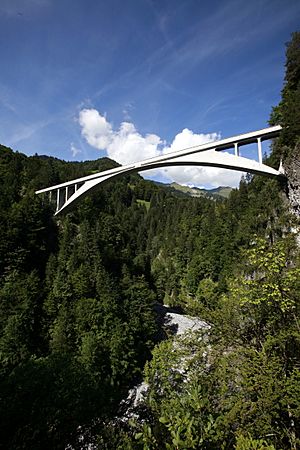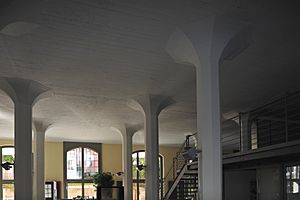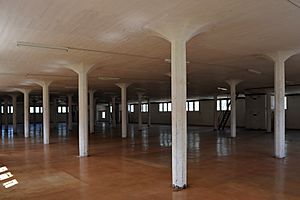Robert Maillart facts for kids
Robert Maillart (born February 16, 1872 – died April 5, 1940) was a Swiss civil engineer. He changed how people used reinforced concrete in buildings and bridges. He designed new types of bridges like the three-hinged arch and the deck-stiffened arch. For buildings, he created the beamless floor slab and the mushroom ceiling.
His bridges, like the Salginatobel Bridge (built 1929–1930) and the Schwandbach Bridge (built 1933), looked very different and changed bridge building forever. They inspired many architects and engineers for years. In 1991, the Salginatobel Bridge was named an International Historic Civil Engineering Landmark by the American Society of Civil Engineers.
Contents
Early Life and Learning
Robert Maillart was born in Bern, Switzerland, on February 6, 1872. He went to the Federal Institute of Technology in Zurich from 1890 to 1894. There, he studied how to build structures. One of his teachers was Wilhelm Ritter, who taught about drawing forces in structures.
Maillart wasn't always the best at school theories. But he was very good at imagining how a structure would work. He also knew it was important to make smart guesses when planning. Before the 1900s, engineers often used shapes that were easy to figure out with math.
Maillart didn't like using too much math. He preferred to step back and use common sense to see how a building or bridge would act in real life. He rarely tested his bridges before they were built. Instead, he would check if they were strong enough after they were finished. He often tested them by walking across them himself! This way of thinking helped him create his amazing new designs.
Maillart's Career Journey
After finishing school, Maillart worked for a company called Pümpin & Herzog in Bern from 1894 to 1896. Then, he worked for the city of Zurich for two years. After that, he joined a private company in Zurich for a few years.
In 1902, Maillart started his own company, Maillart & Cie. In 1912, he moved his family to Russia. He managed big projects there, building factories and warehouses in cities like Kharkov, Riga, and St. Petersburg. Russia was growing fast, and Swiss companies were investing there.
Maillart didn't know that World War I was about to start. He and his family got stuck in Russia. In 1916, his wife passed away. Then, in 1917, the Communist Revolution happened. The new government took control of everything, and Maillart lost all his projects and money. When he returned to Switzerland with his three children, he had no money and was deep in debt.
After that, he had to work for other companies. But even then, he created some of his best designs. By 1920, he moved to an engineering office in Geneva. This office later opened branches in Bern and Zurich.
How Maillart Used Reinforced Concrete
The first time concrete was used a lot in a bridge was in 1856 in France. It was just a huge block of concrete without any extra support. Later in the 1800s, engineers started adding steel bars to concrete. This is called reinforced concrete. They found that concrete was good at handling pushing forces (compression), while the steel bars were good at handling pulling forces (tension). This made concrete a much better material for building strong structures.
A French gardener named Joseph Monier was one of the first to truly understand reinforced concrete. He put iron wire mesh inside concrete. He sold his ideas to builders who then built the first reinforced concrete bridges in Europe. He also made a technique called pre-stressing concrete, which makes concrete arches even stronger.
By the early 1900s, reinforced concrete became a popular building material. It could replace stone, wood, and steel. People like Monier had found good ways to design and build with it. But no one had created new shapes that really showed off how beautiful reinforced concrete could be.
Robert Maillart had a special talent for seeing the beauty in concrete. He designed bridges where the bridge deck and the arch supports worked together as one piece. He made very thin concrete arches and slabs. The Salginatobel Bridge (1930) and Schwandbach Bridge (1933) are perfect examples of his work. They are famous for their elegant look and how they changed bridge design.
These designs were very new for Maillart's time. Both bridges show how Maillart could make designs simple. This allowed him to use materials in the best way and to make the structure fit beautifully with its surroundings. Maillart's design for the Salginatobel Bridge was chosen from 19 entries partly because it was cheaper. Construction began in Schiers, Switzerland, in 1929, and the bridge opened on August 13, 1930.
Maillart is also known for his unique column designs in buildings. He built his first "mushroom ceiling" for a warehouse in Zurich. In this design, the concrete floor was a flat slab, not supported by beams. One of his most famous column designs is in a water plant in Rorschach, Switzerland. Maillart decided to try new ways to build that were "more sensible and more beautiful." His columns had wide, flared tops. This helped spread the weight from the ceiling to the columns better.
He also flared the bottom of the columns. This helped spread the weight from the column over a larger area of the ground. By doing this, the pressure on the soil foundation was reduced.
Many engineers before him had used similar ideas with wood and steel. But Maillart was the first to use concrete in this way. He used concrete because it could support a large amount of earth for insulation against freezing. Since concrete is very strong when pushed, it was perfect for holding a heavy, unmoving mass of earth.
His ideas were used to build the Ponte Del Ciolo (Ciolo's Bridge) in Ciolo, Apulia, Italy.
Maillart's Legacy and Honors
- 1936: He was chosen as a Fellow by the Royal Institute of British Architects (RIBA).
- 1947: The Museum of Modern Art in New York had an exhibit about Robert Maillart, showing his bridges and designs.
- The Salginatobel Bridge was named a Swiss heritage site of national significance.
- 1991: The American Society of Civil Engineers called the Salginatobel Bridge an International Historic Civil Engineering Landmark.
- 2001: The British magazine Bridge – Design and Engineering voted Maillart's Salginatobel Bridge "the most beautiful bridge of the century."
How Engineers Analyzed Structures
By the late 1800s, engineers had made big steps in understanding how to design structures. They learned new ways to draw forces and knew more about how strong materials were. As the 19th century ended, railroads became very important. Engineers needed to know exactly how much stress was on bridge parts because of the heavy trains.
The first solution for this was found by Squire Whipple in 1847. He figured out that the parts of a truss (a type of bridge structure) could be seen as a system of balanced forces. This "method of joints" allowed engineers to find the forces in all parts of a truss if they knew two forces.
The next step was the "method of sections," created by Wilhelm Ritter in 1862. Ritter made it easier to calculate forces with a simple formula. A third improvement was a better way to analyze structures using drawings, developed by James Clerk Maxwell (from the UK) and Karl Culmann (from Switzerland).
Robert Maillart learned these methods. But he was most influenced by his teacher, Wilhelm Ritter. Ritter had three main rules for design. First, he believed in using simple calculations and common sense. Second, he thought it was important to think about how a structure would be built, not just the finished product. Third, he always said to test a structure with full-scale loads. These rules helped engineers learn from structures that were already built.
At the time of Maillart and Ritter, other designers often copied successful old designs. German engineers and scientists had developed complex math methods. They felt so sure about their math that they didn't think they needed to test their designs in real life. However, these math methods didn't encourage engineers to think of new or unusual shapes, because those shapes were hard to analyze with the math they had. Ritter's rules, though, allowed for more unique shapes.
Famous Bridges by Maillart
- Tavanasa Bridge
- Arve Bridge
- Zuoz Bridge
- Stauffacher Bridge
- Salginatobel Bridge
- Schwandbach Bridge
- Bohlbach Bridge
- Rossgraben Bridge
- Traubach Bridge
See also
 In Spanish: Robert Maillart para niños
In Spanish: Robert Maillart para niños
- Mike O'Callaghan – Pat Tillman Memorial Bridge (2010), United States
Images for kids





